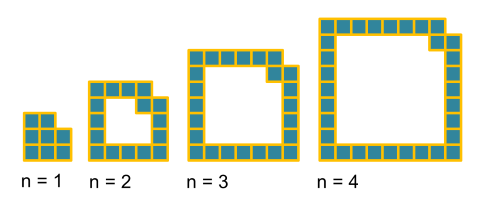Or search by topic
Number and algebra
Geometry and measure
Probability and statistics
Working mathematically
Advanced mathematics
For younger learners
Growing Surprises



Growing Surprises printable worksheet
Take a look at the pattern below:

Can you describe the next few patterns in the sequence?
Can you work out how many squares there are in each pattern?
Is there a quick way to work out the number of squares in the 20th pattern? Or the 50th pattern? Or...
Here's another pattern made from squares:

Can you describe the next few patterns in the sequence?
Can you work out how many squares there are in each pattern?
Is there a quick way to work out the number of squares in the 20th pattern? Or the 50th pattern? Or...
Can you describe any relationships between the two patterns?
Here are two similar linked patterns:

Can you find a quick way to work out how many squares there are in these patterns?
Can you describe any relationships between these two patterns?
You may wish to look at some similar problems, Seven Squares, Attractive Tablecloths and Steel Cables.
With thanks to Don Steward, whose ideas formed the basis of this problem.
You may also like
Days and Dates
Investigate how you can work out what day of the week your birthday will be on next year, and the year after...
Summing Consecutive Numbers
15 = 7 + 8 and 10 = 1 + 2 + 3 + 4. Can you say which numbers can be expressed as the sum of two or more consecutive integers?
Paving Paths
How many different ways can I lay 10 paving slabs, each 2 foot by 1 foot, to make a path 2 foot wide and 10 foot long from my back door into my garden, without cutting any of the paving slabs?

